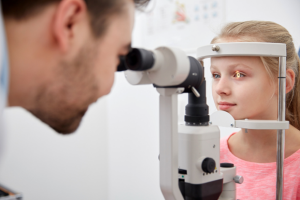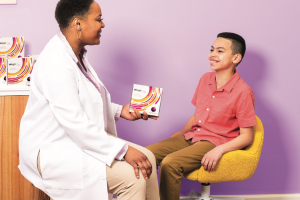
Dr. Shelby Leach shares why on-label first and a myopia treatment’s indication for use are key in helping to preserve a child’s vision.
By Shelby Leach, OD, FAAO
As eye care professionals, your prescribing decisions can be based on some givens: your personal experience, an individual patient’s profile, and valid science behind a treatment that has been vigorously studied and vetted.
The why behind your prescribing is a critical part of patient care. In myopia management, so too is the trust a parent places in you to help protect their child’s vision*†‡ 1,2—an awesome yet fundamental responsibility that is woven into the foundation of our professional oath.
Today, there are several myopia treatments available, all of which have different indications and study strengths behind them.
Below is a framework to help navigate the current myopia treatment landscape.
Follow the Expert’s Roadmap: On-label First
One important rule of thumb to remember: not all myopia treatments are FDA-approved for slowing myopia progression. In fact, there is only one. MiSight® 1 day* has been studied in children as young as 8 years old1 and is indicated to slow the progression of myopia in children aged 8-12 at the initiation of treatment. §1
The International Myopia Institute (IMI) Industry Guidelines and Ethical Considerations for Myopia Control recommends eye care professionals prescribe an on-label, or FDA approved product first if the child has progressive myopia and fits the applicable criteria.3
Several medical devices have been considered on-label in myopia management for their parameter range.1 However, some may confuse myopia management vs myopia control and what is on-label for slowing the progression of myopia — but this isn’t a grey area at all. For example, most orthokeratology designs are on-label for the temporary reduction of myopia (NUU) and extended wear of a gas-permeable contact lens (MWL)1 but are not FDA-approved for slowing myopia progression.
Additionally, off-label treatments for myopia are currently being prescribed in day-to-day practice while their effectiveness and safety profiles are still being investigated in numerous U.S. studies.
The IMI states “Patients should be well informed about whether the treatment product is approved for myopia control or whether it is considered off-label.”3 The distinction is important. Informed consent forms for any off-label treatment should be transparent and thorough, while off-label treatments should adhere to ethical guidelines, with practitioners regularly monitoring patient progress and adjusting treatment plans as necessary, Dr. Andrew Neukirch shares in a recent article.4
Adopt an Evidence-based Medicine Mindset

When considering myopia treatment, eye care professionals can also turn to the hierarchy of the evidence pyramid for guidance.
In this scientific template, evidence toward the top of the pyramid can generally be aligned with higher standards and higher quality evidence.5 The bottom is comprised of case reports, the middle consists of observational cohort studies, and near the top are experimental randomized controlled trials (RCT) with systematic reviews and meta-analyses at the peak.6
In another recent story, Dr. Kyle Klute offers this perspective: “What is important about the pyramid as it pertains to appraising and applying evidence for clinical practice is understanding that the information gleaned from lower levels is much more prone to bias and much less generalizable to broad patient populations. Likewise, evidence extrapolated from higher levels of the pyramid is less prone to bias and more generalizable to broad patient populations. There are exceptions to these statements, of course (for example, a poorly designed or industry-biased RCT may not be better than a well-designed observational cohort study), and there is ongoing controversy in the evidence-based medicine research community as to whether systematic reviews belong at the top., Nonetheless, these broad principles should be used to assess all kinds of evidence.”7
In other words, the pyramid can give you a ballpark, fast answer to the question: Is the evidence behind a treatment the most robust?
It all circles back to where we started—a fundamental of myopia management is trust. Parents trust you with their child’s vision, and you should trust the science behind their child’s treatment. The stakes are too high not to. Help protect the child. And help protect yourself.
Find out more about MiSight® 1 day, in addition to myopia management practice building tools at CooperVision’s Online Success Center.
Dr. Shelby Leach, a Change Agent in The Myopia Collective, is a Calgary, Canada native who graduated Summa cum laude from Arizona State University with a degree in Biological Sciences. She then obtained her Doctor of Optometry degree from the University of California, Berkeley School of Optometry in 2017 as a member of the Beta Sigma Kappa honor society. Upon completion of a Pediatrics/Primary Care Residency at Berkeley Optometry in 2018, she joined the State University of New York College of Optometry as an Assistant Clinical Professor. During her time at SUNY Optometry, Dr. Leach has supervised students in the Pediatrics, Infant Vision, Children with Special Needs, and Myopia Management Clinics. She has held the position of Section Chief of Pediatrics since 2022. She is a co-instructor for the Advanced Topics in Pediatric Ocular Disease and serves as the faculty supervisor of the Pediatrics Micro-Credential Program. She currently holds the position as SUNY College of Optometry Local Society President and a Fellow of the American Academy of Optometry. She will be graduating with an MPH degree in August 2024. In October 2023, she was awarded with Berkeley Optometry’s Inaugural “40 Under 40” Award








